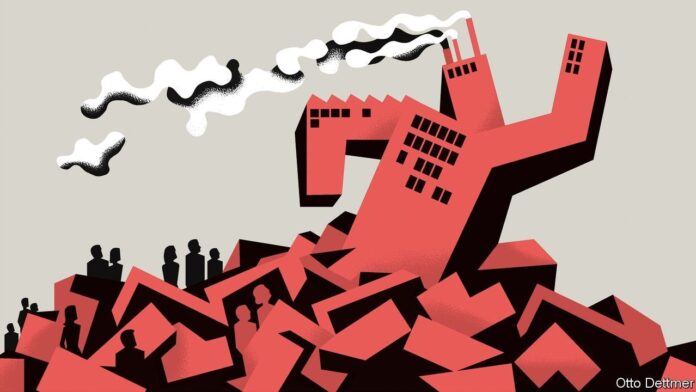A COMMITTEE OF eight prominent economists made it official on July 19th. The covid-19 recession, America’s deepest since the Depression, was also its shortest, spanning just March and April 2020. That tests the very definition of a recession, which the National Bureau of Economic Research describes as “a significant decline in economic activity that is spread across the economy and lasts more than a few months”. A recession it was judged nonetheless, given its breadth and extraordinary depth. The plunge in output in the second quarter of 2020 was more than three times the second-largest quarterly drop in America’s post-war history.
The rebound in GDP, thankfully, has been comparably dramatic. The 33.8% annualised rate of growth notched in the third quarter of 2020 was about twice as fast as the second-best quarterly performance in the post-war era. As the Bureau of Economic Analysis reported on July 29th, output overtook its pre-pandemic level in the second quarter of this year. Though unique in some ways, this unfolding recovery resembles past recoveries in other important respects. It may prove similar enough to help economists gain a better understanding of what policy can achieve in the face of hardship.
Recent American recoveries have tended to be “jobless”, meaning that labour markets have taken far longer to regain lost ground than has overall production. During the seven recessions from 1948 to 1980, it took an average of about five quarters for GDP to surpass its previous peak. Employment took only a little longer to recover: six quarters on average. From the 1980s onwards, however, the recovery in employment began to lag behind that in output. Across the four downturns preceding the covid-19 crisis, GDP regained its peak in just six quarters, on average. But employment did not pass its previous high for a full 15 quarters.
It is not quite right, of course, to call today’s recovery jobless. About 22m jobs were lost between February and April 2020, and 15.6m have since been added back. (Payroll figures for the month of July were due to be released on August 6th, after The Economist went to press.) Still, hiring is once again lagging behind GDP. Though output reached a new high in the second quarter, employment remained more than 4% below its pre-pandemic level. Moreover, the resulting jump in the level of output per worker over the course of this recovery looks remarkably similar to that which followed the global financial crisis (see chart). At present, America is producing more output than it managed just a year and a half ago, with roughly 7m fewer workers.
This would seem to suggest that productivity has leapt across the economy. It may well have done. The pandemic has forced many firms to experiment with new technologies and working patterns and favoured some business models over others. The effect on output per worker in some sectors has been dramatic: labour productivity in retail trade jumped by nearly 8% in 2020, for example. The surge in output per worker also reflects the changing mix of the workforce. Employment in the leisure and hospitality industries, where productivity tends to be low, remains about 13% below the pre-pandemic level, compared to a 4% shortfall in the higher-productivity manufacturing sector.
That productivity-boosting restructuring might accompany a period of economic stress is hardly surprising. In work published in 2012, for instance, Nir Jaimovich of the University of Zurich and Henry Siu of the University of British Columbia analysed the destruction of “routine” jobs—work that follows simple procedures and is thus highly susceptible to automation or outsourcing—and found its incidence to be concentrated around recessions. Furthermore, the researchers noted, the destruction of routine work in recessions seems to account for much of the joblessness of economic recoveries since the mid-1980s. But output per worker eventually stagnated over these plodding recoveries, perhaps because low-wage service-sector work only slowly expanded to absorb the lingering pool of unemployed labour.
The present recovery might reveal whether a more forceful policy response can yield a different outcome. By contrast with past recoveries, this one has been positively blistering, thanks to a burst of deficit spending rivalled only by that during the second world war. Over the first four quarters of the recovery, output rose by just over 12%. Rapid growth is expected to continue; the IMF, for instance, projects that GDP will rise by an impressive 7% in 2021 as a whole, and by a further 5% in 2022.
Push it
How might the future path of jobs and productivity evolve as a result? One scenario is that, powered by stimulus, the economic expansion remains rapid, but that early gains in productivity fail to be preserved. Consumer demand would shift back towards labour-intensive services, leading to frantic hiring. The result would be a jobs-rich recovery, but a productivity-poor one. Were the economy to grow as projected by the IMF and output per worker to fall back to pre-pandemic levels, then employment would rise towards 166m by the end of 2022, compared with 146m today. That would mean there were some 14m more jobs than in February 2020, when the unemployment rate stood at 3.5%.
Another possibility looms, however. Perhaps growth in expanding, high-productivity industries, which can afford to pay higher wages, will continue, leaving fewer people willing to fill low-productivity, low-wage service-sector jobs. Where past jobless recoveries might have encouraged the creation of more low-wage services jobs, a faster expansion today might break the link, perhaps forcing employers in these industries to automate instead. America would enjoy a jobs-rich recovery while also emerging from the pandemic structurally changed, with a permanent increase in its level of productivity.
Wishful thinking, perhaps. But whatever the outcome, America’s spending will have purchased a faster recovery and new information about how best to ease the pain of a recession. And it might just have gained a productivity boost. ■
This article appeared in the Finance & economics section of the print edition under the headline “Something ventured”
Credit: Source link










